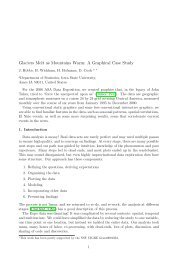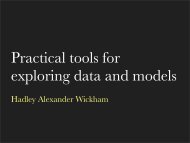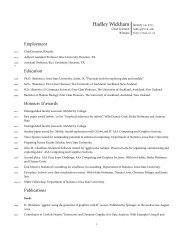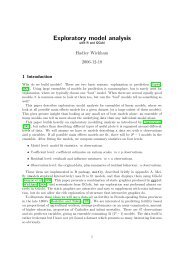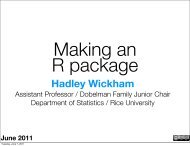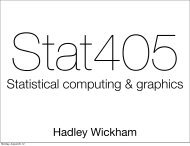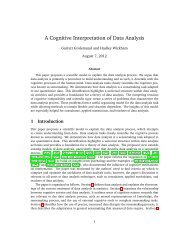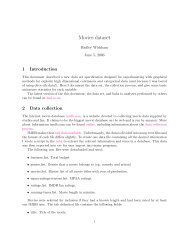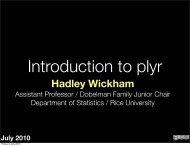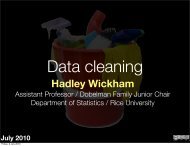Statistical inference for exploratory data analysis ... - Hadley Wickham
Statistical inference for exploratory data analysis ... - Hadley Wickham
Statistical inference for exploratory data analysis ... - Hadley Wickham
You also want an ePaper? Increase the reach of your titles
YUMPU automatically turns print PDFs into web optimized ePapers that Google loves.
4362 A. Buja et al.<br />
1. Introduction<br />
Exploratory <strong>data</strong> <strong>analysis</strong> (EDA) and model diagnostics (MD) are two <strong>data</strong><br />
analytic activities that rely primarily on visual displays and only secondarily on<br />
numeric summaries. EDA, as championed by Tukey (1965), is the free-wheeling<br />
search <strong>for</strong> structure that allows <strong>data</strong> to in<strong>for</strong>m and even to surprise us. MD, which<br />
we understand here in a narrow sense, is the open-ended search <strong>for</strong> structure not<br />
captured by the fitted model (setting aside the diagnostics issues of identifiability<br />
and influence). Roughly speaking, we may associate EDA with what we do to<br />
raw <strong>data</strong> be<strong>for</strong>e we fit a complex model and MD with what we do to trans<strong>for</strong>med<br />
<strong>data</strong> after we fit a model. (Initial <strong>data</strong> <strong>analysis</strong> (IDA) as described in Chatfield<br />
(1995), where the assumptions required by the model fitting are checked visually,<br />
is considered a part of, or synonymous with, EDA.) We are interested here in<br />
both EDA and MD, insofar as they draw heavily on graphical displays.<br />
EDA, more so than MD, has sometimes received an ambivalent response.<br />
When seen positively, it is cast as an exciting part of statistics that has to do<br />
with ‘discovery’ and ‘detective work’; when seen negatively, EDA is cast as the<br />
part of statistics that results in unsecured findings at best, and in the overor<br />
misinterpretation of <strong>data</strong> at worst. Either way, EDA seems to be lacking<br />
something: discoveries need to be confirmed and over-interpretations of <strong>data</strong><br />
need to be prevented. Universal adoption of EDA in statistical analyses may<br />
have suffered as a consequence. Strictly speaking, graphical approaches to MD<br />
deserve a similarly ambivalent response. While professional statisticians may<br />
resolve their ambivalence by resorting to <strong>for</strong>mal tests against specific model<br />
violations, they still experience the full perplexity that graphical displays can<br />
cause when teaching, <strong>for</strong> example, residual plots to student novices. Students’<br />
countless questions combined with their tendencies to over-interpret plots impress<br />
on us the fact that reading plots requires calibration. But calibrating inferential<br />
machinery <strong>for</strong> plots is lacking and this fact casts an air of subjectivity on their use.<br />
The mirror image of EDA’s and MD’s inferential failings is confirmatory<br />
statistics’ potential failure to find the obvious. When subordinating common<br />
sense to rigid testing protocols <strong>for</strong> the sake of valid <strong>inference</strong>, confirmatory<br />
<strong>data</strong> <strong>analysis</strong> risks using tests and confidence intervals in assumed models that<br />
should never have been fitted, when EDA be<strong>for</strong>e, or MD after, fitting could have<br />
revealed that the approach to the <strong>data</strong> is flawed and the structure of the <strong>data</strong><br />
required altogether different methods. The danger of blind confirmatory statistics<br />
is there<strong>for</strong>e ‘missed discovery’. This term refers to a type of failure that should<br />
not be confused with either ‘false discovery’ or ‘false non-discovery’, terms now<br />
often used as synonyms <strong>for</strong> ‘Type I error’ and ‘Type II error’. These confirmatory<br />
notions refer to trade-offs in deciding between pre-specified null hypotheses<br />
and alternative hypotheses. By contrast, ‘missed discovery’ refers to a state of<br />
blindness in which the <strong>data</strong> analyst is not even aware that alternative structure<br />
in the <strong>data</strong> is waiting to be discovered, either in addition or in contradiction to<br />
present ‘findings’. Statistics there<strong>for</strong>e needs EDA and MD because only they can<br />
<strong>for</strong>ce unexpected discoveries on <strong>data</strong> analysts.<br />
It would be an oversimplification, though, if statistics were seen exclusively<br />
in terms of a dichotomy between the <strong>exploratory</strong> and the confirmatory. Some<br />
parts of statistics <strong>for</strong>m a mix. For example, most methods <strong>for</strong> non-parametric<br />
modelling and model selection are algorithmic <strong>for</strong>ms of <strong>data</strong> exploration, but some<br />
Phil. Trans. R. Soc. A (2009)<br />
Downloaded from<br />
rsta.royalsocietypublishing.org on January 7, 2010



